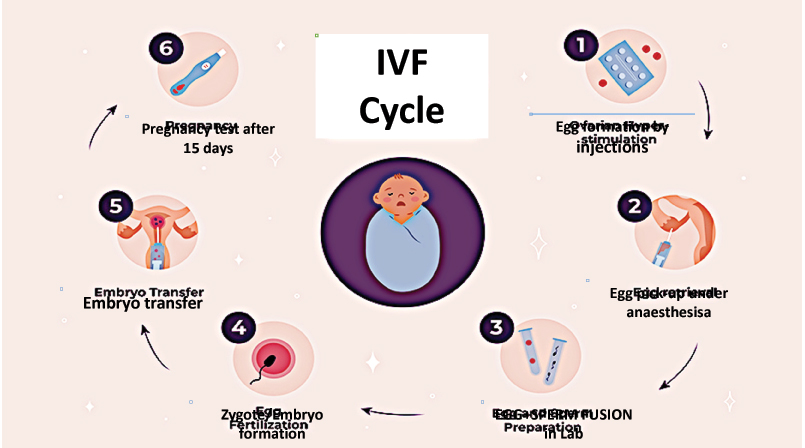In Vitro Fertilization (IVF)
- Home
- In Vitro Fertilization (IVF)

In Vitro Fertilization (IVF)
In vitro fertilization (IVF) is a fertility treatment that involves fertilizing an egg outside the body and then implanting the resulting embryo in the uterus.
Q. What is IVF/ test-tube baby?
In Vitro Fertilization (IVF) is one of the most advanced and widely used fertility treatments available today globally. Assisted conception techniques like IVF and ICSI involve the laboratory preparation of gametes, artificially bringing them closer together and and the subsequent transfer of the resulting embryo into the woman’s uterus; bypassing natural barriers.
Q. What are the various indications where IVF is recommended?
(i) Tubal damage
(ii) Moderate to severe endometriosis
(iii) Severe male factor infertility
(iv) Unexplained Infertility
(v) ovulation disorders,
(vi) Coital Dysfunction
(vii) Pre-Implantation Genetic Testing
Q. What are the prerequisites for IVF?
For a couple to undergo IVF, the female partner should have at least one functioning ovary and a normal uterus, and the male partner should have at least one sperm per ejaculate. However, absence of eggs in ovaries and absence of sperm can be bypassed with oocyte donation and sperm donation. Absence of a uterus can be taken care of by IVF surrogacy.
Q. What are the success rates of IVF?
Though IVF has a high success rate compared to other fertility treatments, the outcome depends on various factors, like woman’s age, the quality of the sperm and eggs, and the presence of other fertility-related issues. The average success rate for women under 35 is about 50-60%, though this number decreases with age.
Q.Are there any side-effects related to IVF procedure?
IVF comes with physical, emotional, and financial challenges.The hormone treatments used for ovarian stimulation can cause side effects, like increased risk of ovarian hyperstimulation syndrome (OHSS) or multiple pregnancies (twins, triplets). However, for many, the benefits of IVF far outweigh the risks, especially when other methods of conception have been unsuccessful.
Q. What are the steps involved in IVF cycle?
(i) Ovarian Stimulation
(1 a) IVF process begins with ovarian stimulation, where woman is given hormone injections daily, given subcutaneous/ intramuscular such as follicle-stimulating hormone (FSH) and /or lutenizing hormone (LH), to encourage her ovaries to produce multiple eggs (as opposed to the single egg normally released in a natural cycle).
(1 b) During this period, regular monitoring through blood tests and ultrasounds is done
(ii) Egg Retrieval (Oocyte Aspiration)
(2 a) Once the follicles have matured to (at least 3 eggs >17mm size) , a trigger injection (often human chorionic gonadotropin /hCG or GnRH agonist/ leuprolide) is given to induce final egg maturation.
(2 b) Eggs are collected through a minor surgical procedure using ultrasound guidance using thin needle (17G) inserted through the vaginal wall into the ovaries.
(2 c) Procedure is performed under sedation or anesthesia, making it relatively quick and painless.
(iii) Sperm Collection and Preparation
(3 a) On the day of the egg collection, male partner provides a semen sample, or donor sperm is used.
(3 b) The semen is processed and prepared in the lab, where it is washed and concentrated to ensure that only the good quality and most motile sperm are used for fertilisation.
(iv) Fertilization
The retrieved eggs and prepared sperm are combined in a laboratory dish for fertilisation. There are two primary methods of fertilisation:
(a) Conventional fertilization (IVF): Sperm and eggs are placed together in a dish, allowing fertilization to occur naturally.
(b) Intracytoplasmic sperm injection (ICSI):
(b1) A single sperm is injected directly into the egg, which is often used in cases of severe male infertility or previous fertilization failure.
(b2) Fertilized eggs (now embryos) are monitored under microscope for 3 to 5 days to ensure proper development.
(v) Embryo Culture
Embryos are cultured in the lab, where they develop into multicellular organisms till day 3 or day 5 (blastocyst stage)
(vi) Embryo Transfer (ET)
Using a thin catheter, the embryo(s) are carefully placed into the woman’s uterus through the cervix in a simple, painless procedure.
(vii) Luteal Phase Support
After ET, woman is typically prescribed progesterone (either as an injection, pill, or suppository) to support the uterine lining and aid in the embryo’s implantation.
(viii) Pregnancy Test
About 10 to 14 days after the embryo transfer, a blood test (beta hCG) is conducted to determine if the embryo has implanted successfully and if pregnancy has been achieved.
(ix) Freezing of Extra Embryos
(9 a) If there are more healthy embryos than needed for the current cycle, they can be frozen (cryopreserved) for future use.
(9 b) These frozen embryos can be used in subsequent cycles without the need for ovarian stimulation and egg retrieval, making future IVF attempts easier and less expensive.

